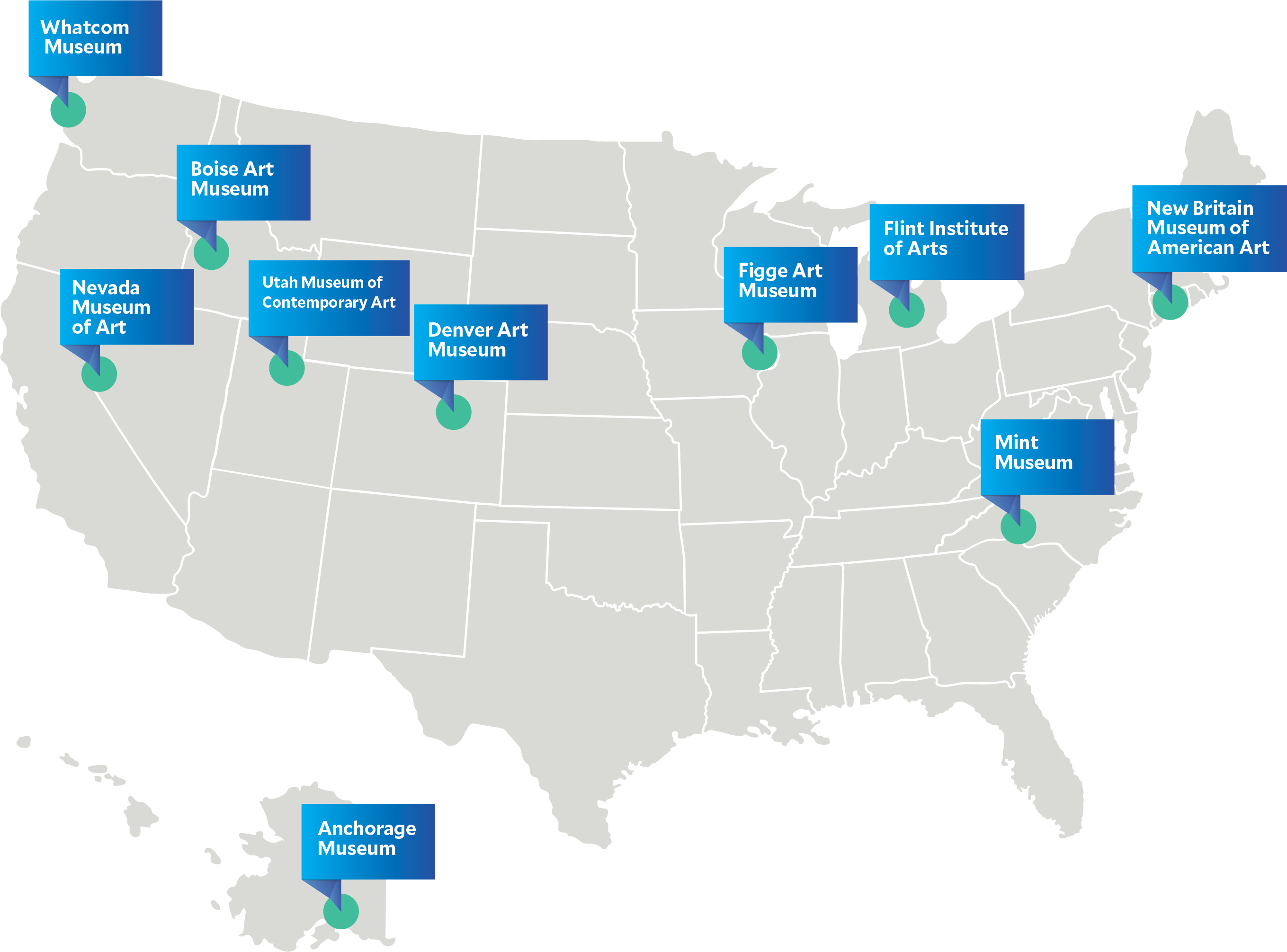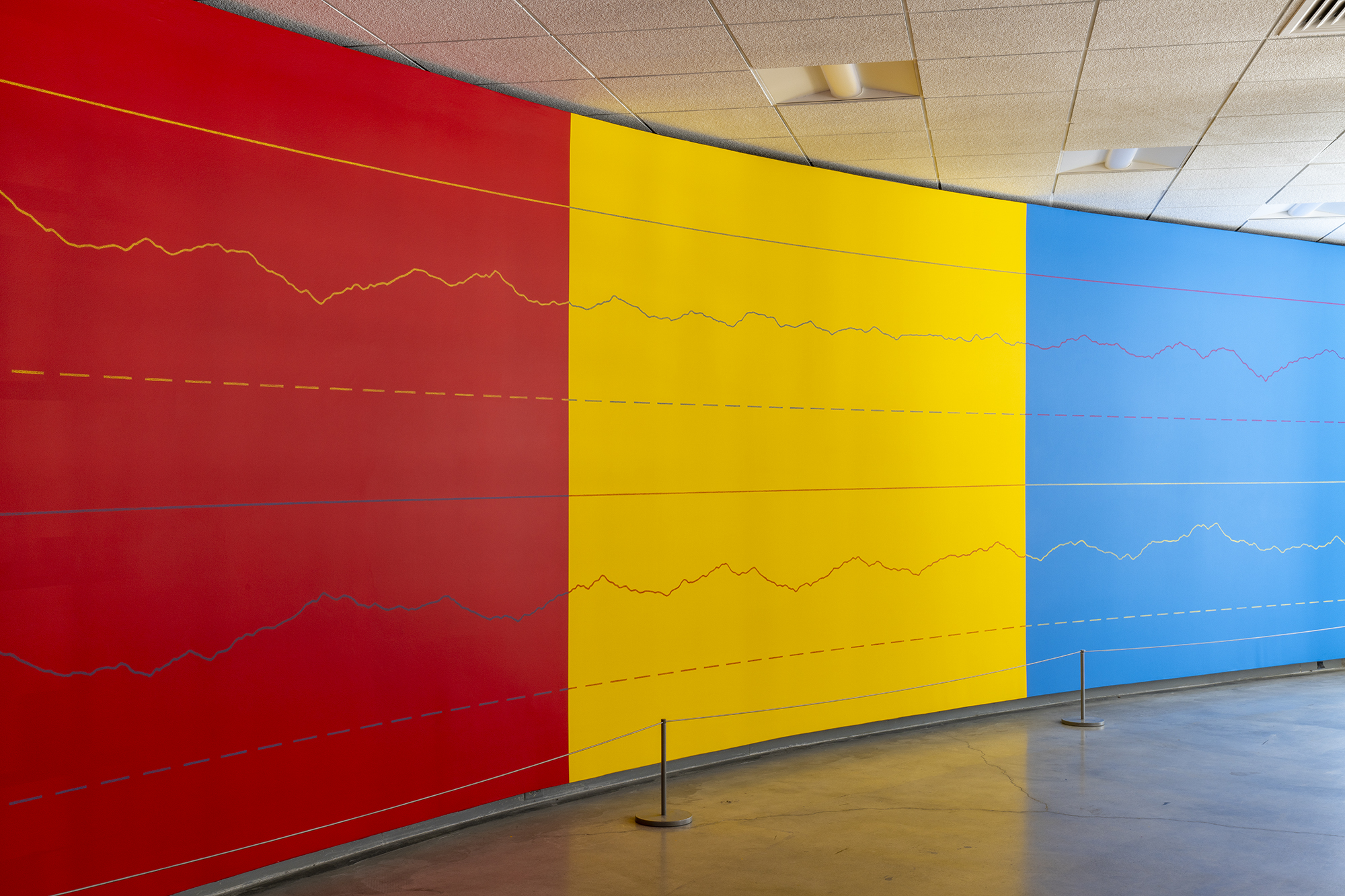Across the Nation
We're sending art across America. You can soon see highlights from the National Gallery's collection at 10 museums in 10 states, from Connecticut to Alaska.
Launching ahead of 2026's commemoration of the 250th anniversary of the United States of America, this program brings standout works from our permanent collection to small and mid-size museum. Our partner museums selected works that introduce new perspectives to their own galleries and complement their public programs and interests.

Alaska
The Anchorage Museum
On view now

Georgia O'Keeffe, Winter Road I, 1963, oil on canvas, Gift of The Georgia O'Keeffe Foundation, 1995.4.1

Mark Rothko, Untitled, 1958, oil and acrylic on canvas, Gift of The Mark Rothko Foundation, Inc., 1986.43.150

Nancy Graves, Consequence, 1982, oil on canvas, Corcoran Collection (Gift of the Friends of the Corcoran), 2015.19.181
Colorado
Denver Art Museum
On view now

Rembrandt van Rijn, A Woman Holding a Pink, 1656, oil on canvas, Andrew W. Mellon Collection, 1937.1.75

Rembrandt Workshop, Portrait of Rembrandt, 1650, oil on canvas, Widener Collection, 1942.9.70
Connecticut
New Britain Museum of American Art
On view by May 2025

Robert Seldon Duncanson, Fruit Still Life, c. 1849, oil on canvas, Corcoran Collection (Museum Purchase through a gift from the Reserve for Purchase of Works of Art), 2014.136.106

Winslow Homer, East Hampton Beach, Long Island, 1874, oil on canvas, Collection of Mr. and Mrs. Paul Mellon, 2012.89.2
Idaho
Boise Art Museum
On view beginning April 19, 2025

Mark Rothko, Untitled, 1950, pigmented hide glue and oil on canvas, Gift of The Mark Rothko Foundation, Inc., 1986.43.159

Mark Rothko, Untitled, 1948, oil on canvas, Gift of The Mark Rothko Foundation, Inc., 1986.43.120

Thomas Eakins, Harriet Husson Carville (Mrs. James G. Carville), 1904, oil on canvas, Gift of Elizabeth O. Carville, 1976.27.1

Berthe Morisot, Young Woman with a Straw Hat, 1884, oil on canvas, Ailsa Mellon Bruce Collection, 1970.17.49
Iowa
Figge Art Museum
On view May 3, 2025

Lucas Cranach the Elder, The Nymph of the Spring, after 1537, oil on panel, Gift of Clarence Y. Palitz, 1957.12.1

Louis Vallée, Silvio with the Wounded Dorinda, 165(1)?, oil on canvas, Gift of Patricia Bauman and the Honorable John Landrum Bryant, 2000.114.1

Frans Hals, Portrait of a Member of the Haarlem Civic Guard, c. 1636/1638, oil on canvas, Andrew W. Mellon Collection, 1937.1.68

Sir Anthony van Dyck, Catherine Howard, Lady d'Aubigny, c. 1638, oil on canvas, Widener Collection, 1942.9.95

Antwerp 16th Century (Possibly Matthys Cock), The Martyrdom of Saint Catherine, c. 1540, oil on plywood transferred from panel, Samuel H. Kress Collection, 1952.2.18

Studio of Justus Sustermans, Mattias de' Medici, c. 1660, oil on canvas, Gift of Ursula H. Baird and Sally H. Dieke in memory of their grandmother, Constance Cary Harrison, 1950.10.1

Gerard Soest, Lady Borlase, c. 1672/1675, oil on canvas, Gift of Mr. and Mrs. Gordon Gray, 1977.63.1

after Willem Kalf, Still Life with Nautilus Cup, 1665/1670, oil on canvas, Gift of Robert H. and Clarice Smith, 1974.109.1

Philip van Kouwenbergh, Flowers in a Vase, c. 1700, oil on canvas, Gift of Mr. and Mrs. William Draper Blair, 1976.26.2

Circle of Jacob Adriaensz Bellevois, Dutch Ships in a Lively Breeze, probably 1650s, oil on canvas, Gift of Mrs. Robert Giles, 1947.3.1
Michigan
Flint Institute of Arts
On view beginning April 9, 2025

Andy Warhol, Mao, 1973, acrylic and silkscreen ink on linen, Corcoran Collection (Gift of the Friends of the Corcoran Gallery of Art), 2014.79.50

Sandro Botticelli, The Virgin Adoring the Child, 1480/1490, tempera on poplar panel, Samuel H. Kress Collection, 1952.2.4

Hans Memling, Madonna and Child with Angels, after 1479, oil on panel, Andrew W. Mellon Collection, 1937.1.41
Nevada
Nevada Museum of Art
On view beginning April 12, 2025
North Carolina
Mint Museum
On view beginning April 10, 2025

Alma Thomas, Autumn Drama, c. 1969, acrylic on canvas, Corcoran Collection (The Evans-Tibbs Collection, Gift of Thurlow Evans Tibbs, Jr.), 2015.19.211

Georgia O'Keeffe, Jack-in-Pulpit - No. 2, 1930, oil on canvas, Alfred Stieglitz Collection, Bequest of Georgia O'Keeffe, 1987.58.1

Edgar Degas, Dancers Backstage, 1876/1883, oil on canvas, Ailsa Mellon Bruce Collection, 1970.17.25
Utah
Utah Museum of Contemporary Art
On view now

Sol Lewitt, Wall Drawing No. 307 / Blue circles, red grid, yellow arcs from four corners, black arcs from the midpoints of four sides., 1977, colored pencil, 1991.241.76
Washington
Whatcom Museum
On view now

Henri Matisse, Still Life with Sleeping Woman, 1940, oil on canvas, Collection of Mr. and Mrs. Paul Mellon, 1985.64.26

Auguste Renoir, Picking Flowers, 1875, oil on canvas, Ailsa Mellon Bruce Collection, 1970.17.61

Paul Cezanne, The Battle of Love, c. 1880, oil on canvas, Gift of the W. Averell Harriman Foundation in memory of Marie N. Harriman, 1972.9.2